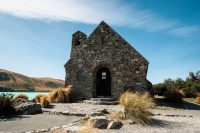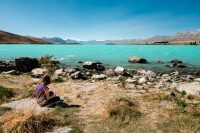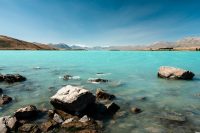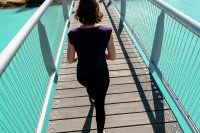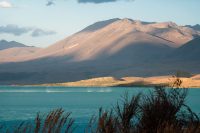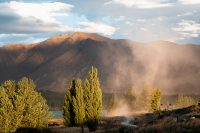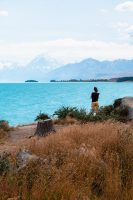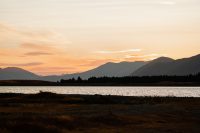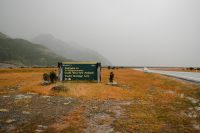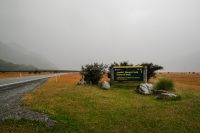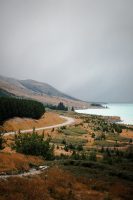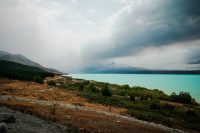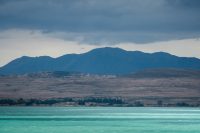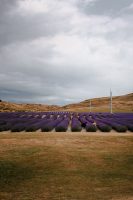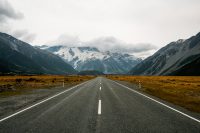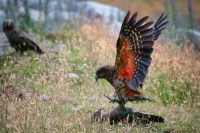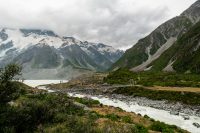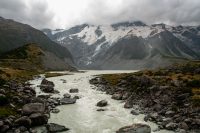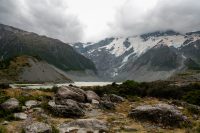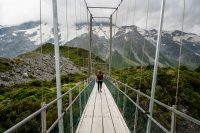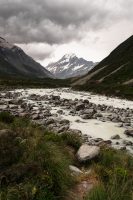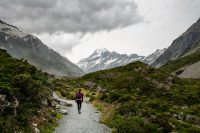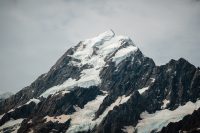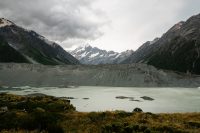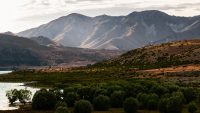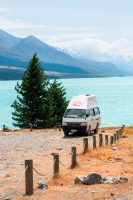Look up at the night sky in Aoraki Mackenzie International Dark Sky Reserve to see the Southern Cross, Magellanic Clouds, Milky Way, and much more.
Table of Contents
An introduction to Aoraki Mackenzie International Dark Sky Reserve
As of this writing, there are 16 International Dark Sky Reserves. Until recently, Aoraki Mackenzie International Dark Sky Reserve had the distinguished honor of being the only Dark Sky Reserve in the Southern Hemisphere.
The Aoraki Mackenzie International Dark Sky Reserve covers 4,367 square kilometers, including Aoraki/Mt. Cook National Park and the Mackenzie Basin, on the South Island of New Zealand. This area was designated an International Dark Sky Reserve in 2012 and, until 2019, was the only Dark Sky Reserve in the Southern Hemisphere.
Highlights of Aoraki Mackenzie International Dark Sky Reserve
Lake Tekapo Scientific Reserve
Lake Tekapo is a glacial lake known for its stunning turquoise water. These days it is a popular stop for bus tours; you are not likely to be alone when snapping a photo of the lake or the Church of Good Shepherd that sits on the lake shore.
Night Sky Gazing / Dark Sky Tour
A number of dark sky tour operators are located in Tekapo. After researching the various operators and their offerings, we selected the Summit Experience offered by Dark Sky Project. This experience includes telescope time at the University of Canterbury Mt John Observatory.
However, we are unable to provide a review of the experience because our tour was cancelled due to high winds. Due to the weather forecast and limited tour availability, we were unable to re-book for another night.
TIP: If dark skies and star gazing is your thing, plan to spend multiple nights in the region. Weather can be unpredictable and tours book out quickly.
That being said, the Aoraki Mackenzie International Dark Sky Reserve covers a large area and we had wonderfully dark skies on many other nights. We are disappointed to have missed out on Mt John Observatory and telescope viewing but there is still much to see with the naked eye.
Mt. John University Observatory & Summit Circuit Track
Mt. John Observatory is not only a great place for night sky viewing, it also serves up spectacular daytime views when walking a loop track at the summit.
Mt. John Observatory Summit Circuit Track
8.9 km return // 3 hr return
The Mt. John Observatory Summit Circuit Track is accessed from an entrance near Tekapo Hot Springs. This 8.9km walk climbs steadily until the summit; allow 3 hours. Or you can drive to the summit which entails paying a 8 NZD road use fee and spend 30-45 minutes walking around a loop track at the summit.
On our second visit to Tekapo in July 2020 we paid the road use fee and wandered around the short loop track at the summit. The track has 360 degree views of the Mackenzie basin, Lake Tekapo, and the surrounding mountains.
Lake Pukaki Reserve
Lake Pukaki is the largest lake in the region. It is another glacial lake with beautiful turquoise water but also boasts views of Aoraki/Mt. Cook from much of its shoreline.
When travelling to or from Aoraki/Mount Cook National Park, a portion of the drive will be alongside Lake Pukaki.
TIP: There are a number of freedom camping sites on the shore of Lake Pukaki. Don’t miss out on an overnight in one of the most spectacular settings in the world.
Aoraki/Mount Cook National Park
In addition to being located within the boundaries of the Aoraki Mackenzie International Dark Sky Reserve, Aoraki/Mount Cook National Park is located within the much larger Te Wāhipounamu/South West New Zealand World Heritage Area.
Aoraki/Mount Cook National Park covers 722 km and is one of 13 national parks in New Zealand. Aoraki/Mount Cook National Park is most notable for its alpine setting.
The park contains New Zealands’ tallest mountain: Aoraki/Mount Cook. Aoraki/Mount Cook is 3,724 m (12,218 ft) tall. Indeed, 19 out of the 20 New Zealand peaks over 3,000 meters are located within the park.
The park also contains Tasman Glacier, the longest glacier (~27 km long and 4 km wide) in New Zealand. In fact, glaciers cover 40% of the park area; the park is home to eight of the twelve largest glaciers in New Zealand.
Also, notably, the world’s only alpine parrot – the endangered kea – can be found in Aoraki/Mount Cook National Park.
TIP: Beware of the keas. They are super cute but also super intelligent. They will most certainly damage or relieve you of your possessions if you don’t keep a watchful eye!
The alpine features of the park make it a popular destination for mountaineering activities. Scenic hikes (tramps) abound. We enjoyed the following tracks:
Hooker Valley Track
10 km return // 3 hr return // 80 m elevation gain
The Hooker Valley Track was listed as a “Best of NZ Day Walk” by Lonely Planet. We totally agree! This flat track is an easy walk with spectacular scenery. You’ll cross over three swing bridges as you make your way up the Hooker Valley. Mountain and glacial views abound but the real treat sits at the end of the track. Here you’ll find a beautiful turquoise glacier lake, likely complete with floating icebergs, sitting under magnificent views of Hooker Glacier and Aoraki/Mount Cook.
We got caught in some strong winds and rain during our walk but, nonetheless, recommend that you do NOT skip the Hooker Valley Track.
Kea Point Track
2.8 km return // 1 hr return // 180 m elevation gain
If, after the Hooker Valley Track, you’re craving another vantage point of the Hooker Valley and Aoraki/Mount Cook, then Kea Point Track is an option. You’ll walk through grasslands to the Mueller Glacier moraine wall where you’ll find a viewing deck that affords views of Mount Sefton, Hooker Valley, Mueller Glacier lake, and Aoraki/Mount Cook. An interpretive panel provides information as well.
Blue Lakes & Tasman Glacier View Track + Tasman Lakes Track
2.6 km return // 40 min return // 100 m elevation gain
The Blue Lakes & Tasman Glacier View Track was listed as a “Best of NZ Short Walk” by Lonely Planet. When we visited in February 2020 we experienced poor weather and visibility so we were unable to concur firsthand with that opinion.
However, when we visited Mt. Cook National Park again in July 2020 we had fine weather and can definitely conclude that the track is in a ‘best of’ class. The track has good views of the lower Tasman Glacier and lake – often with icebergs – as well as the mountains at the head of the valley.
TIP: Walk down the junction to the Tasman River. You might be able to touch the icebergs!
Sealy Tarns Track + Mueller Hut Route
Sealy Tarns: 3-4 hr return // 600 m elevation gain
Mueller Hut Route: 3-5 hr one-way // 1000m elevation gain
Although we did not tackle the Mueller Hut Route, we’d be remiss to discuss Aoraki/Mount Cook National Park without mentioning this popular track.
The Sealy Tarns Track is the first half of the Mueller Hut Route. There are 2,200 steps up to Sealy Tarns. Thankfully, as you ascend the stairs, you’ll be gifted views of Hooker Valley and Aoraki/Mount Cook to distract from the burn.
During the summer months, it is possible for trampers to continue to ascend beyond Sealy Tarns to Mueller Hut. Mueller Hut may be familiar as it’s a favorite Instagram shot due to its vibrant red color. Be sure to check with DOC staff on current conditions and to book your overnight hut stay before departing.
Camping in Aoraki Mackenzie International Dark Sky Reserve
We suggest using the information and bountiful reviews in the CamperMate app to find campsites suitable for your situation and inline with your expectations.
TIP: If you’re coming from Christchurch and want to split the journey to Lake Tekapo into two days, the Arundel Bridge Campsite in Geraldine is a freedom camping option. There’s also a nice library with free wi-fi and a yummy cheese/ice cream shop in Geraldine.
These are the campsites at which we stayed in Aoraki Mackenzie International Dark Sky Reserve:
Lake McGregor, Tekapo
Lake Pukaki Reserve
Patterson Ponds
Whitehorse Hill Campground, Aoraki/Mt. Cook National Park
White Horse Hill Campground is the only campground within Aoraki/Mount Cook National Park. It’s basically a big parking lot with some adjoining grass.
TIP: We found all of these campsites to be quite busy during the January/February high season. Plan to arrive early so as not to be disappointed.
New Zealand Planning and Resources
If you’re planning for your vacation or holiday in New Zealand, more resources – including our trip map with points of interest and camping spots – can be found in our New Zealand planning and resources post.
Our travelogue and the details of our day-to-day activities can be found in our New Zealand itinerary and travelogue post.
travel dates: January 29, 2020 – February 2, 2020 & July 9 – 11, 2020
last updated: 03-Jun-2021


